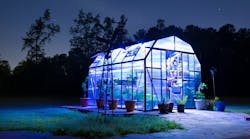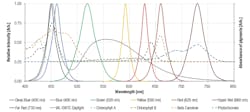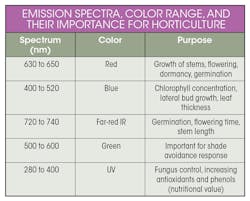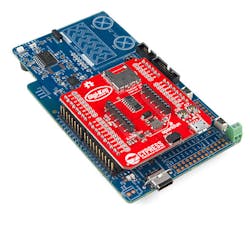Versatile Greenhouse Toolkit Adds LEDs to the Mix
Download this article in PDF format.
One of the reasons the IoT is just an acronym to most people is that they can’t relate to something they can’t visualize, which makes the Green House Solution program from Digi-Key, Cypress Semiconductor, and Sparkfun a real standout. This state-of-the-art set of horticulture technology building blocks checks all the boxes: It’s relatable because you build something that produces results you can see (and taste); genuinely useful and scientifically challenging; combines “solar-free” farming with multiple high-tech technologies; and represents a new wave in the food-to-table concept.
However, one thing has been missing from their Green House Solution: A state-of-the-art LED lighting manufacturer with a product line dedicated to this application. That’s now been taken care of, as Wurth Electronik has joined this merry band. The $15 billion German company makes a diverse array of products, and one of its most recent additions is horticultural LED lighting—a key ingredient in state-of-the-art indoor growing
Greenhouse horticulture isn’t new. Millions of protected plant enclosures populate the world, and most of them have traditionally used natural light and relatively unsophisticated heating, watering, and control systems. However, thanks in part to the development of products and technology to support IoT applications, sensors, controllers, short-range RF transceivers, and other components can be networked and to autonomously expand their capabilities.
Sponsored Resources:
- PSoC 6 Wireless Sensor Network IoT Development Platform
- Going Green(house) with Cypress and Sparkfun
- Wurth Electronics Horticulture LED Lighting
The LED Wave
The viability of LEDs in this application is relatively recent as their intensity was previously too low to be practical. However, this has been dramatically improved in recent years so that their output is comparable to high-intensity discharge (HID) light sources when used in clusters.
Greenhouses have generally used HID lamps, such as high-pressure sodium (HPS), mercury vapor, and metal halide, to complement sunlight. But they aren’t well-suited for “solar-free” farms because even though some are efficient and long-lasting, when compared to LEDs, they’re gluttons. They also generate lots of heat that uncontrollably impact the indoor environment and must be compensated for to produce stable conditions.
For example, LEDs produce very little heat even with their supporting electronics, have very long operating lives, and are highly efficient. When operated below their maximum operating temperature, LEDs can last for up to 60,000 hr., while a 1000-W HPS lamp will last for 10,000 to 24,000 hr. and metal halide lamps have a lifespan of 6,000 to 20,000 hr.
1. Shown are the spectral emissions from Wurth LEDs (solid lines) overlaid with the absorption spectra of photosynthetic pigments in plants (dotted lines).
LEDs also have a benefit unique to themselves among lighting sources. They have the ability to vary color temperature on demand, effectively creating a variable spectral environment. The benefits from this are immense for indoor horticulture. To see why, look at Figure 1, which overlays the spectral range of emissions from Wurth LEDs (solid lines) with the absorption spectra of photosynthetic pigments in plants (dotted lines). The characteristics of each spectral segment and its effects are shown in the table.
Because of their monochromatic output, multiple LEDs of different wavelengths can be combined to configure light scenarios specific to species, growth phases, and other factors. This is important because HID sources have a fixed output spectrum that delivers sufficient quantities of light at some wavelengths while providing excessive or deficient quantities at others.
Depending on the plant, the stages and cycles of plant development can be controlled by providing different wavelengths of light, which can “customize” the spectral environment to increase yields, reduce growing times, change when plants flower, how they taste, their nutritional content, and even how long the last before becoming unusable. It’s also possible, as several people have demonstrated, to create multiple types of a single plant to meet different tastes.
In addition, because LEDs can be operated close to the canopy with a smaller emission pattern, and as they emit only the specific wavelengths used by plants, they produce much less wasted light and reduce energy costs. The small size of LEDs and their fixtures, in combination with their low operating temperatures, allows them to be positioned in places HID sources cannot, such as within the lighting canopy without risk of burns to operators. Also, due to their low operating temperature, LED fixtures can be fully or partially encased, which can be water- and dust-resistant.
Farming-Centric LEDs
Wurth offers a family of LEDs dedicated to vertical farming, indoor farming, and multilayer cultivation that cover all the spectral regions important for plants from 2700K through 6500K (daylight). The line of WL-SMDC SMD mono-color LEDs was recently expanded to include wavelengths of 450 nm (deep blue), 660 nm (hyper red), and 730 nm (far red) that are optimized to match the absorption spectra of photosynthetic pigments.
The Wurth LEDs nicely complement the PSoC 6 wireless sensor network IoT development kit that combines Cypress PSoC 6 microcontrollers, sensors, and now LED lighting to create a solution for remote monitoring and control of indoor horticultural environments. The Cypress Bluetooth Low Energy Pioneer board (Fig. 2) is the development platform for the PSoC 6 family that includes an onboard debugger, Arduino-compatible headers, CapSense widgets, and other features, along with a PSoC 6 processor. The PSoC 6 a dual-core device with a Cortex-M0+ low-power and Cortex-M4 high-power processors and I/O for peripherals and memory.
The Cypress Add-On Shield that plugs into the Pioneer board includes XBee 802.14.5-based communications, Qwiic, and microSD functionality for the PSoC 6 and any Arduino R3 shield-based board. The program is supported by documents and tools for communicating with Raspberry Pi via Bluetooth and Wi-Fi, and between a PSoC 4 Pioneer Board and the PSoC 6 board via Bluetooth Low Energy.
If you’re interested, please check out these references that should get you well on your way to constructing a state-of-the-art solar-free horticulture management and lighting solution. And as development can be a lonely endeavor, make sure the Sparkfun site is one of your first stops. In addition to over 2,000 open-source components and widgets, it provides training and online tutorials and a community always ready to help, including: PSoC 6 development platform, Sparkfun’s “Using the PSoC Pioneer Board with the Pioneer IoT Add-on Shield,” and Wurth Electronics’ “LED It Grow.”
Sponsored Resources:
- PSoC 6 Wireless Sensor Network IoT Development Platform
- Going Green(house) with Cypress and Sparkfun
- Wurth Electronics Horticulture LED Lighting
Related Resource:



